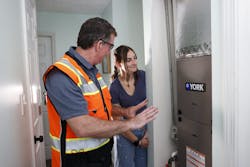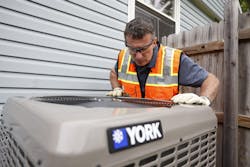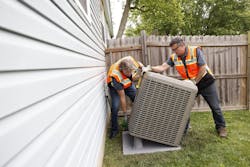Heat pump innovation, along with smarter controls, have made dual fuel systems a practical, reliable solution for homeowners who want to optimize comfort and save money at the same time. By combining electric efficiency with the dependability of gas heat, dual fuel systems deliver premium comfort using the most cost-effective utility option. In colder regions of the United States, these systems can save homeowners up to $1000 per year.
Recent advancements in heat pump technology have made it possible for homeowners in colder climates like the Northeast and Midwest to take advantage of the energy efficiency and cost savings of heat pumps for most home heating and use a furnace as a backup heat source. This gives contractors in these areas a new opportunity to sell, install and service heat pumps as part of a dual fuel system.
Smarter Controls Make Dual Fuel Systems Possible
A dual fuel system combines two heat sources: an electric heat pump and a gas or propane furnace. During spring, fall and some of the winter, the heat pump delivers efficient heating by transferring warmth from the outside air into the home. When temperatures fall below the heat pump’s operating range, the system automatically switches to the furnace. A single thermostat controls the whole system, which intelligently automates the transition between heat pump and furnace.
Two-stage and inverter-driven compressor technologies have helped make dual fuel systems efficient and practical. Compared to single-stage heat pumps that can only operate in “on” or “off” settings, two-stage inverter-driven compressors allow the system to run at a lower, more efficient speed and continuously modulate its output. In colder conditions, this extended heating cycle enables the heat pump to more effectively extract heat from the ambient air and pull it inside the home. As a result, homeowners receive consistent, precise heating and cooling year-round. The YORK® YH6 heat pump is an example of a modern residential heat pump with a two-stage inverter-driven compressor and intelligent controls. This unit pairs easily with furnaces for dual fuel applications, such as the highly efficient YORK Y92E, a two-stage condensing gas furnace.
Adoption Is Growing
Efficiency, comfort, reliability and intelligent controls are among the many reasons why dual fuel systems are attractive to homeowners.2 Newer heat pumps are capable of delivering reliable heating even when temperatures dip into the single digits, with some models performing in conditions as low as -13 degrees Fahrenheit.
Many homeowners have also benefited from financial incentives offered by local, state and federal governments along with some utility companies. The federal government is offering up to $2,600 as a tax credit until the end of 2025. To help negotiate a successful sale, contractors should research incentives available in their area. Additionally, some manufacturers offer flexible financing plans to make these systems more widely accessible.
A New Sales Opportunity for Contractors
Dual fuel systems provide contractors with a new way to boost revenue while also giving them a modern, high-efficiency option to recommend to customers, with a wide range of flexibility in matching heat pumps to gas or propane furnaces based on a customer’s need.
Contractors can sell the system based on the projected long-term energy savings and emphasize superior comfort as an advantage over electric-only or gas-only setups. System redundancy is a compelling sales feature, which gives homeowners peace of mind that they have one of the most reliable systems available.
Keys to Successful Installations
According to Department of Energy estimates, up to 70% of heat pump installations have at least one performance compromising fault that could have been avoided through proper commissioning.1 Attention to detail and following best practices will go a long way in ensuring a successful installation. Two areas for extra consideration are ductwork and heating loads. Evaluate and correct ductwork before installation as undersized ducts can cause airflow problems and high-pressure faults. For proper load sizing, heating loads determine furnace size while cooling loads dictate the heat pump size. If the heat pump is sized for heating, it will be oversized when cooling.
In addition to ductwork and heating loads, it’s also critical to verify airflow, refrigerant charge and thermostat settings. Setting up the thermostat for a dual fuel system is essential to receiving full system benefit. For most installations, the contractor will configure the thermostat to set the changeover point between the heat pump and the furnace. Outdoor sensors are recommended to ensure the system makes the switch at the correct temperature. Incorrect configuration can cause both systems to run at once.
Contractors should use and follow manufacturer resources for installation, including wiring diagrams and installation manuals. The manufacturer may have an app to streamline installation and help eliminate errors, such as the GoTemp Pro app, which helps streamline installation and ensure accuracy.
A Smarter, More Profitable Solution
Dual fuel systems give homeowners the best of both worlds: efficient, all-electric heating and cooling and dependable gas or propane heat as backup. Customers enjoy precision comfort and reduced long-term costs while contractors have a premium upsell opportunity backed by proven homeowner savings and strong manufacturer support. Dual fuel is a smarter way to meet homeowners needs today and a profitable opportunity for contracts to add to their offering.
1. U.S. Department of Energy (September 2024), “Heat pump quality installation and commissioning,” https://basc.pnnl.gov/resource-guides/heat-pump-quality-installation-and-commissioning#edit-group-description
2. Consegic Business Intelligence (April 2025), “Residential Furnace Market - Size, Share, Industry Trends, and Forecasts (2025-2032),”
Sponsored by:



